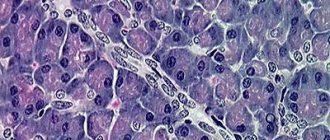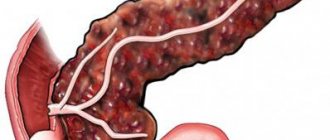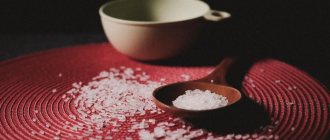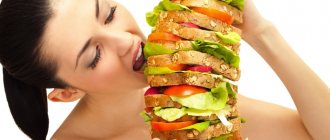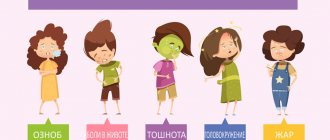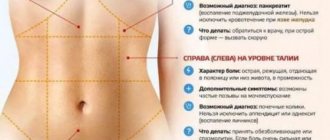Author Andrey Mikhailov
10/25/2002 13:39 (Updated: 07/02/2021 14:25)
Health
Statistics show that pancreatitis has become a very common disease in recent years. For example, in our country there are 27.4–50 cases of chronic pancreatitis per 100,000 people, and the picture is approximately the same in European countries. The number of patients suffering from the acute form of the disease is also increasing: in Russia, the frequency of cases ranges from 10 to 13% of the total number of patients with surgical pathologies of the abdominal organs.
Pancreatitis: types, causes and symptoms of the disease
In medicine, pancreatitis is defined as an inflammatory disease of the pancreas - one of the most important human organs, responsible for the production of digestive juice and playing a key role in the entire process of digestion and absorption of food.
According to the classification, there are several main forms of pancreatitis:
- Acute pancreatitis , in which the activation of digestive enzymes in the pancreas itself occurs, as a result of which its tissues are affected - “self-digestion” of the organ occurs, accompanied by swelling and necrosis of cells, as well as possible damage to surrounding tissues and organs. The causes of acute pancreatitis can be diseases of the bile ducts (35%), abdominal trauma, poisoning, and severe allergic reactions. But one of the main factors provoking the disease is alcohol abuse (55% of cases are caused by this very reason).
- Acute recurrent pancreatitis resembles a mild form of acute pancreatitis, but is characterized by repeated attacks of varying degrees of intensity. This form is very difficult to diagnose.
- Chronic pancreatitis (CP) is an independent, slowly progressive disease of the pancreas, which is characterized by alternating periods of exacerbations and remissions. Traditionally, alcohol abuse is also considered one of the main reasons for the development of CP (60–70%). In addition, the disease can also be caused by an unhealthy diet with a predominance of fatty and spicy foods, which provokes excessive stress on the pancreas. Sometimes CP occurs as a result of the spread of a stomach or duodenal ulcer to the gland. There are two main stages of the disease. The first can last several years, while the patient is practically not bothered by anything. This stage, without proper treatment, will inevitably progress to the next, at which the damage to the organ turns out to be very serious, symptoms appear constantly and periods of exacerbation often occur.
Acute and chronic pancreatitis in the acute stage is characterized by three common symptoms:
- sharp and severe pain in the upper abdomen, girdling the body or radiating to the back,
- profuse vomiting that does not bring relief,
- and tension in the muscles of the upper abdomen, revealed during the examination.
Any form of pancreatitis sooner or later leads to pancreatic enzyme insufficiency, in other words, a lack of digestive enzymes.
Symptoms of enzyme deficiency in pancreatitis are usually very pronounced - this
- flatulence,
- heartburn,
- nausea,
- polyfecal.
One of their characteristic signs is the presence of undigested lumps of food and a large amount of fat in the feces. This happens due to the fact that the digestive system cannot cope with the digestion of food, which remains in the intestinal lumen and irritates it, while the flow of nutrients into the blood is significantly reduced. Due to poor absorption of nutrients, the patient eventually develops vitamin deficiency, anemia and, as a result, general exhaustion of the body.
Medicines for exacerbations
Therapeutic and supportive measures should be started immediately after the first symptoms of the acute process appear. If the pain is severe, you need to call an ambulance or take the person with the attack to the hospital yourself.
For moderate pain, treatment can be carried out at home, but only if the person is under the supervision of a doctor and knows what medications can be taken in case of exacerbation of pancreatitis. Therefore, the appropriate tablets should always be in the first aid kit. Treatment of symptoms of an attack of pancreatitis is primarily aimed at relieving pain symptoms and eliminating irritation of the mucous membranes of the gland. First aid measures:
- taking an analgesic or antispasmodic drug prescribed by your doctor, or giving an intramuscular injection;
- applying a cold compress to the area with pain (this can be a heating pad containing crushed ice, any product from the freezer, wrapped in cloth to prevent frostbite of the skin);
- maintaining shallow breathing with short delays (this helps reduce pain symptoms);
- elimination of suppression of vomiting, which alleviates the general condition.
It is important to maintain bed rest for several days, adjust your diet and drinking regimen.
From the group of analgesics and antispasmodics
Such products should be present in the home medicine cabinet of every patient with pancreatitis, including in chronic form. This will avoid the need to call an ambulance by quickly relieving pain with medications that are at hand.
The tasks of antispasmodics are to dilate the blood vessels of the organ, relieve spasms of the smooth muscles of the bile ducts and the sphincter of Oddi. The latter causes a failure in the outflow of pancreatic juice and bile fluid into the cavity of the duodenum.
The maximum duration of treatment with antispasmodics is no more than 2 days, since such drugs can cause serious adverse reactions.
Due to the fact that the pain syndrome associated with the disease is often long-lasting and acute, it is better to use drugs from the analgesic group in the form of a solution for intravenous injections
Injectables act much faster than their tablet counterparts. Severe pain is relieved with blockades of analgesic drugs, which are no less effective than injections.
From the group of anti-inflammatory drugs and enzymes
Since the pain syndrome is directly related to the exacerbation of the inflammatory process, drugs are prescribed that help suppress the corresponding reaction.
Inflammation can develop not only in the pancreas itself, but also spread to nearby organs (stomach and others).
To suppress inflammation, you need to take non-steroidal anti-inflammatory drugs or broad-spectrum antibiotics. These together reduce the risk of developing negative consequences, including:
- blood poisoning;
- peritonitis;
- abscess;
- pancreatic necrosis (inflammatory-necrotic process in organ cells).
Drugs from the group of enzymes that compensate for the production of enzymes in the gland also help prevent complications. These are prescribed after the acute phase has stopped. Pancreatin-based products are used more often. Preparations with bile acids help increase the production of pancreatic juice, so they are rarely used.
From the group of antisecretory agents
Drugs are prescribed to reduce the volume of enzymes produced by the pancreas and stop the progression of necrotic changes that can develop during self-digestion.
Antisecretory medications are prescribed at any stage, including during exacerbation of symptoms, to reduce the intensity of pain at an early stage of the disease.
The mechanism of action of antisecretory medications is associated with suppression of the synthesis of hydrochloric acid in the gastric environment, blocking histamine H2 receptors.
Antisecretory drugs are also prescribed for the reason that in 20-25% of cases pancreatitis occurs with ulcerative lesions, the changes characteristic of which extend to the head and body of the pancreas.
As a result, the motor function of the duodenum is impaired, duodenal hypertension develops, and duodenal-pancreatic reflux is formed. Due to such changes, control of acid production in the stomach is required, which helps smooth out clinical manifestations.
Which means are the most effective?
Popular drugs used for pancreatitis can be placed in the table:
| Group of drugs | Representative | Contraindications |
| Analgesics | Paracetamol | Hypersensitivity, severe impairment of liver and kidney function, children under 3 years of age |
| Baralgin | Hypersensitivity, severe kidney disease, liver disease, bronchial asthma, bronchospasm, blood pathologies, pregnancy in the 1st and 3rd trimesters | |
| Antispasmodics | No-shpa | Hypersensitivity, cardiac, renal or liver failure, children under 6 years of age |
| Papaverine | Hypersensitivity, renal failure, elderly and children under 6 years of age | |
| Anti-inflammatory | Diclofenac | Hypersensitivity, impaired hematopoietic function, gastric and duodenal ulcers, exacerbation of intestinal disease, children under 6 years of age, pregnancy in the 3rd trimester |
| Ibuprofen | Hypersensitivity, exacerbation of gastrointestinal disease, bleeding disorders, renal and liver failure, children under 6 years of age for effervescent tablets and up to 12 years for regular tablets, capsules, granules | |
| Antisecretory | Kvamatel | Hypersensitivity, pregnancy and lactation, children and adolescents under 18 years of age, liver and kidney failure |
| Omeprazole | Hypersensitivity, pregnancy and lactation | |
| Enzymes | Mezim | Hypersensitivity, exacerbation of pancreatitis |
| Festal | Hypersensitivity, exacerbation of pancreatitis, liver failure and coma, hepatitis |
What can cause exacerbation of chronic pancreatitis?
Chronic pancreatitis is an insidious disease; a person can live peacefully and not feel symptoms for a long time. But what plays the role of a “trigger” in the transition of the disease to the exacerbation phase? The same reasons that cause the development of the disease itself.
- Firstly, an acute attack of pancreatitis occurs due to a violation of the diet. Overeating, especially if the regular menu contains a large number of spicy and fatty foods, fast food, smoked meats and canned food, inevitably leads to excessive stress on the diseased organ.
- Secondly, this is the same frivolous attitude towards alcohol - drinking alcohol even in relatively small doses can transfer the disease to an acute stage.
- Thirdly, the impetus can be intoxication due to acute respiratory viral infections or taking certain medications: chronic patients should be careful about any drug therapy, especially if it was not prescribed by a doctor.
- Fourthly, some autoimmune diseases (for example, cystic fibrosis), physical fatigue or chronic stress can trigger the onset of an attack of pancreatitis.
The first and main signal about the onset of an attack of pancreatitis is the appearance of acute pain in the epigastric region, sometimes radiating to the back or the heart area - this symptom is typical for 80–90% of all patients. After eating, the pain usually increases; it can be reduced by sitting or bending forward. Sometimes the pain cannot be eliminated by taking painkillers, and as its intensity increases, even painful shock and loss of consciousness are possible.
Pain during exacerbation of pancreatitis may appear an hour or two after eating fatty or spicy foods. It happens that an attack of pancreatitis begins later - after 6-12 hours. An even longer “delay” is often observed after alcohol abuse - it can reach two or even three days. In medical practice, there have been cases of the onset of an attack in the next few minutes as a result of drinking cold fizzy drinks. In some cases, pain has no obvious connection with food intake at all.
As chronic pancreatitis worsens, the patient develops
- specific bitterness in the mouth,
- whitish coating on the tongue,
- loss of appetite,
- nausea,
- vomiting that does not improve the patient’s well-being.
Reasons for the development of pancreatitis
Inflammation of the pancreas is caused by cell damage from various factors. The main reasons for the development of pancreatitis are:
- metabolic disorders;
- mechanical damage to the pancreas;
- past infections;
- immune system disorders.
Inflammation of the pancreas occurs against the background of alcohol abuse, smoking, and high concentrations of calcium in the body (hypercalcemia). The metabolism of alcohol and nicotine produces free radicals that damage cells. With hypercalcemia, pancreatic enzymes (amylase, protease, lipase) crystallize and turn into hard stones that damage the ducts of the gland. Biliary pancreatitis occurs due to disturbances in the functioning of the liver and gallbladder. Inflammation of the gland can occur against the background of viral infections (hepatitis B, mumps) and autoimmune diseases (Crohn's disease, ulcerative colitis).
Sometimes inflammation of the pancreas can occur due to other pathologies of the gastrointestinal tract: gastritis, infectious intestinal diseases. This form of pancreatitis is called reactive because inflammation develops faster than with other forms of pancreatitis.
How long does an attack of chronic pancreatitis last?
To accurately answer the question “How long does an attack of pancreatitis last?” difficult - from an hour to several days, and the period of exacerbation of pancreatitis with regularly recurring attacks - from a week or more.
It is impossible to treat an exacerbation on your own: according to statistics, approximately 15–20% of patients die from complications that arose during an attack. When it starts, you should immediately call an emergency medical team, and before it arrives, it is recommended to follow a few simple recommendations to slightly alleviate the patient’s condition.
Acute pancreatitis
In addition to severe abdominal pain, acute pancreatitis is characterized by a significant increase in the concentrations of pancreatic enzymes: trypsin (breaks down proteins), lipase (breaks down fats) and amylase (breaks down carbohydrates). In most cases, pancreatitis occurs in an edematous (mild) form without pancreatic necrosis, and symptoms disappear within a few days. Sometimes a necrotic form of inflammation develops, in which the functions of the cardiovascular system, lungs or kidneys are disrupted. If you have pancreatitis, you need to call an ambulance when the first symptoms appear (severe abdominal pain, vomiting), since without treatment, acute inflammation of the pancreas can become purulent and lead to death.
First aid for an attack of pancreatitis
The first aid formula is simple - “cold, hunger and rest.” During an attack, a patient needs to be provided with all three of its components as soon as possible:
- completely exclude the intake of any food and liquids (except for clean, cool water) in order to relieve the load on the pancreas - this ban will remain in effect until the person’s condition returns to normal;
- put the patient in bed on his back; if vomiting, it is permissible to take a position on his side with his knees pressed to his stomach;
- apply a cold compress to the pancreas area.
In this case, it is prohibited to take medications on your own - competent assistance for exacerbation of pancreatitis can only be provided by a doctor in a hospital setting. It is there that the patient will undergo an examination, and based on a set of diagnostic measures, he will be prescribed adequate therapy.
This complex includes
- palpation,
- laboratory diagnostics, including a detailed clinical, biochemical blood test and bacteriological examination of abdominal exudate (performed during surgery),
- enzyme research and instrumental diagnostics - ultrasound of the abdominal organs,
and according to indications -
- MRI,
- computed tomography (radiography).
During treatment, severe pain is relieved with the help of analgesics and antispasmodics, the latter are also necessary to restore the normal outflow of pancreatic juice. If an infection is detected or during surgery, antibacterial drugs are prescribed. To reduce pancreatic activity, it is possible to prescribe somatotropin antagonists. According to indications, gastric contents are pumped out and intensive detoxification therapy is carried out.
During the period of exacerbation of pancreatitis, the use of enzyme preparations is contraindicated.
To correct changes in the patient’s body, appropriate symptomatic treatment is used, which may include drugs that support heart function, normalize blood pressure, and others.
If a patient develops necrosis of pancreatic tissue—pancreatic necrosis—an operation is performed to remove it.
Treatment methods for pancreatitis
In the absence of proper treatment, pancreatitis can become chronic, manifesting itself in the form of exacerbations (symptoms of chronic pancreatitis during an exacerbation are similar to the symptoms of acute pancreatitis). The development of complications such as atrophy, fibrosis, calcification of the pancreas, and pancreatic necrosis is possible. Such complications can be fatal.
Under no circumstances should you self-medicate pancreatitis. In addition to the risk of complications, it is worth considering that you cannot focus only on your own interpretation of pain. Similar pain can be caused not only by pancreatitis, but also by other reasons. Pancreatitis must be diagnosed by a doctor.
In case of acute pain, you should call an ambulance.
Treatment of acute pancreatitis
carried out in a hospital.
Treatment of chronic pancreatitis
aimed at restoring pancreatic function. If seeking medical help was timely, then a fairly rapid restoration of the functions of the pancreas in full is possible.
The course of treatment includes:
Diet correction
Treatment of chronic pancreatitis includes the appointment of a special diet, which involves the exclusion of spicy and fatty foods, alcohol, and a low carbohydrate content.
Drug treatment
During the period of restoration of pancreatic function, medications containing pancreatic enzymes are prescribed.
Treatment of cholelithiasis
A factor contributing to the development of pancreatitis is, for example, cholelithiasis. Therefore, treatment of chronic pancreatitis includes measures to treat this disease (removal of the gallbladder).
Make an appointment Do not self-medicate. Contact our specialists who will correctly diagnose and prescribe treatment.
Rate how useful the material was
thank you for rating
What can be done after an exacerbation of pancreatitis
After an attack of pancreatitis is relieved, treatment should be aimed primarily at supporting the function of the pancreas and its ability to fully digest food entering the body. The pancreas is not capable of self-healing, which means it cannot work without support during chronic pancreatitis. That is why one of the main directions of treatment during remission is enzyme therapy - the same one that is not allowed during exacerbation of the disease.
Enzyme replacement therapy is not capable of restoring the pancreas, but can take over some of its functions. The corresponding enzyme preparations are prescribed for a long time, sometimes for life - with their help, the human body fully receives all the nutrients it needs from food.
But this is not the only function of enzyme-containing drugs: their ability to relieve pain itself and minimize the secretory function of the pancreas, providing it with functional rest, has been proven. This ability is realized through the mechanism of reverse inhibition of enzyme production.
In addition to enzyme therapy, the patient is prescribed a special diet, which also reduces the load on the affected organ. It is recommended to refuse
- animal fats,
- sour, fried, salty, smoked foods,
- strong broths and soups based on them.
And, of course, they fall under a complete ban
- alcohol
- and smoking.
Relieving attacks in chronic pancreatitis and especially the subsequent prevention of pancreatic insufficiency require long-term and well-coordinated collaboration from the doctor and the patient. Self-medication in this case can easily lead to serious complications that can be life-threatening.
Disclaimer : This content, including advice, provides general information only. It is in no way a substitute for qualified medical opinion. Always consult a specialist or your healthcare provider for more information.
Add Pravda.Ru to your sources in Yandex.News or News.Google , or Yandex.Zen
Quick news in the Telegram channel of Pravda.Ru . Don't forget to subscribe to stay updated on events.
Pancreatitis: treatment + diet. Effective treatment of the pancreas without drugs or with drugs
Curator: Marina Chizhikova, Elena Enenkova, Alla Ponomareva
Types of pancreatitis
There are acute and chronic forms of inflammation of the pancreas. Separately, pseudotumorous pancreatitis is distinguished, when the pancreas enlarges due to inflammation and begins to put pressure on nearby organs, interfering with their proper functioning.
Acute pancreatitis occurs due to sudden damage to the pancreas by gallstones formed due to cholelithiasis and frequent alcohol consumption. Therefore, the acute form of pancreatitis appears more often in adults. Without proper treatment, inflammation of the pancreas can develop into chronic pancreatitis.
With a chronic form of inflammation, scars appear in the pancreas, which can cause it to stop performing its functions. Often chronic pancreatitis occurs against the background of genetic and autoimmune diseases associated with dysfunction of the endocrine glands (cystic fibrosis).
Specialists
| 5.0 137 reviews | Chizhikova Marina Dmitrievna Gastroenterologist Experience 31 years Doctor of the highest category Admission from 3300 rub. |
| 5.0 139 reviews | Enenkova Elena Alekseevna Gastroenterologist Experience 33 years Doctor of the highest category Admission from 2400 rub. |
| 4.9 126 reviews | Ponomareva Alla Vasilievna Gastroenterologist Experience 36 years Doctor of the highest category Admission from 2500 rub. |

